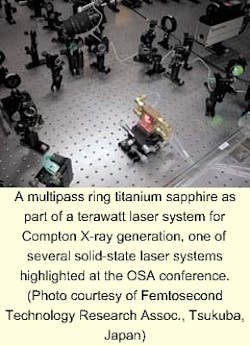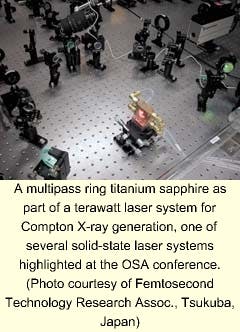ASSL showcases latest solid-state laser research
CONFERENCE REVIEW
The Optical Society of America's annual Advanced Solid-State Lasers (ASSL) topical meeting provides an intimate setting for world leaders of the solid-state laser community to gather and enjoy both formal presentations and informal discussions on the latest breakthroughs in solid-state laser technology. This year's conference was no exception, attracting more than 320 attendees to the three-day conference in Seattle, WA.
The event featured an informative program organized by conference chair Chris Marshall of Lawrence Livermore National Laboratory (LLNL; Livermore, CA) and program chair Larry Marshall of Lightbit Corp. (Stanford, CA). Keynote speakers included David Welch of SDL (San Jose, CA) and Almantas Galvanauskas of IMRA, America (Ann Arbor, MI).
The conference opened with a talk by Gary Koop of TRW (Redondo Beach, CA) about the status of the airborne laser (ABL) program. A series of presentations about high-power diode-pumped lasers followed, starting with a paper on a novel end-pumped zig-zag slab laser architecture by researchers at TRW. More than 400 W multimode and 228 W in a beam 1.35 times the diffraction limit was extracted from a Yb:YAG laser in an architecture that avoids several problems inherent in side-pumped slabs and has the potential for power scaling.
In another novel architecture for generating high brightness, researchers at Heriot-Watt University (Edinburgh, Scotland) demonstrated 121 W continuous wave (CW) output from a planar waveguide Nd:YAG laser. The highest laser power was reported in paper TuC2 by researchers from Germany, who produced nearly 5 kW of CW power from a Nd:YAG laser. Also of interest, researchers at Mitsubishi Electric Corp. (Amagasaki, Japan) presented their results on high-power and highly efficient lasers. They reported achieving 150 W of CW, single-mode output with better than 10% electrical efficiency, and more than 500 W of quasi-CW output (M2 = 4) at better than 20% electrical efficiency.
Lasers using materials that lase directly in the mid-infrared spectral region were also high-lighted. Researchers at the Naval Research Labs (Washington DC) presented the first demonstration of a room-temperature, diode-pumped 4.6-µm erbium-doped potassium lead chloride (KPb2Cl5) laser. Chromium-doped zinc selenide (Cr2+:ZnSe) was shown by a few research groups to be a viable material for tunable and ultrashort-pulse laser sources in the 2.1- to 2.5-µm wavelength range. In paper MC2, a collaboration of researchers from the Photonics Institute in Vienna, the University of Pisa, and LLNL demonstrated modelocked operation of Cr2+:ZnSe, and in paper MC3, high-power operation (>1 W laser-pumped and 15 mW diode-pumped) was demonstrated by researchers from Belarus and the University of Hamburg.
Advances in short-pulse laser sources were discussed, with researchers presenting their work on the generation of higher peak powers and higher repetition rates from solid-state lasers. In paper MF2 from the University of Stuttgart (Stuttgart, Germany), a diode-pumped thin disk Yb:YAG regenerative amplifier generated 1-mJ, 5-ps pulses at a repetition rate of 10 kHz. Such a source may find its way into future micromachining applications. Advances in terawatt-class laser sources based on Ti:sapphire were also presented, with paper MF4 from the University of Colorado at Boulder, JILA (Boulder, CO) demonstrating an 8-W, 1-kHz, 20-fs laser as the pump source for generating soft x-ray pulses of light, and paper MF5 from the Femtosecond Technology Research Association, Japan, demonstrating a highly stable terawatt laser source (5.3 W, 50 Hz, 78 fs) for a laser synchrotron x-ray source (see figure). Also of interest was paper MF7 from the Swiss Federal Institute of Technology, which described a miniature Nd:YVO4 laser with a 77 GHz repetition rate using soliton modelocking to generate short 2.7-ps pulses. Such a laser source is of interest for a number of applications, such as communications, photonic switching, and laser spectroscopy.
Fiber lasers
Fiber lasers took a session of their own, led by David Welch, who discussed recent advances in solid-state laser/amplifier technologies and the impact these advances will have on future telecommunications applications. Eye-safe fiber lasers are increasing in power, with researchers from the University of Southampton (Southampton, England) demonstrating 6.7 W from an erbium-ytterbium (Er-Yb) co-doped cladding-pumped fiber laser tunable from 1533 to 1600 nm. Ultrafast pulse generation from fiber lasers and amplifiers was also highlighted, with impressive results from IMRA America. Paper TuA3 described generation of 52-fs pulses using a Yb fiber amplifier. Almantas Galvanauskas discussed recent techniques, which allow using fibers with core sizes beyond the single-mode limit to increase the energy and power from ultrashort pulsed fiber lasers. In post-deadline paper PD3, IMRA reported obtaining compressed 380-fs pulses with energy of more than 1 mJ from a large-core Yb-doped double-clad fiber. This energy from a femtosecond all-fiber system represents an order of magnitude increase compared to what previous researchers have achieved.
Robert L. Byer from Stanford University (Palo Alto, CA) gave an entertaining historical perspective on the advances made in solid-state laser technology during the past 40 years. Byer has started, or been connected with, numerous successful laser companies and has a unique understanding of what it takes to turn a laboratory curiosity into a real product.
The visible and ultraviolet (UV) laser session was highlighted by the breaking of the 1-W level of visible radiation from a diode-pumped self-doubling material. In paper WA3, researchers at Macquarie University (Australia) described the generation of 1.1 W of CW green output from the self-doubling crystal Yb:YAB. The UV laser presentations were dominated by researchers from Japan. Highlights included an all-solid-state, CW laser producing 2.3 mW at 195 nm from Sony Corp. (Tokyo, Japan); direct generation of UV ultrafast pulses in a Ce:LiCAF crystal reported in paper WA7, and improved crystal quality of the increasingly important CLBO crystal, reported by the Osaka University group.
New to the meeting this year was a cash prize for the best presentation by a student. Sponsored by Lightbit, the award will be given annually at the ASSL meeting. This year's winner was Justin Mansell, a graduate student in Byer's group at Stanford University. Mansell presented a postdeadline paper on a new micromachined deformable mirror for compensating thermal aberrations in a laser beam.
Advanced Solid State Lasers 2002 will be held in Quebec City, Quebec, Canada, Feb. 3 to 6.
Mark S. Bowers
MARK S. BOWERS is principal scientist at Aculight Corporation, 11805 North Creek Parkway S., Suite 113, Bothell, WA 98011; e-mail [email protected].

